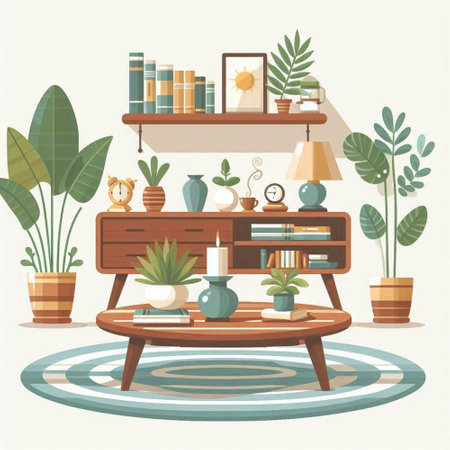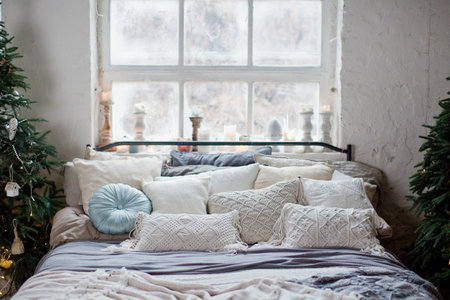Introduction to Texture Layering in Bedroom Design
When it comes to designing a bedroom that truly feels like your own sanctuary, layering different textures is an essential strategy. This approach goes beyond simply picking out stylish furniture or trendy colors—its about creating an atmosphere that is both cozy and inviting. By thoughtfully combining fabrics, woods, and metals, you add depth and character to your space, making it feel lived-in and uniquely yours. Texture layering helps transform a flat, uninspired room into a warm retreat where you can relax and recharge. Whether youre drawn to the softness of linen bedding, the rustic charm of reclaimed wood, or the sleek touch of brushed metal accents, mixing these elements brings personality and comfort to your bedroom design. In American homes, where individuality and comfort are highly valued, mastering texture layering is key to achieving that perfect balance between style and serenity.
Choosing the Right Fabrics for Comfort and Style
When it comes to layering textures in your bedroom, fabrics play a crucial role in both comfort and aesthetics. Selecting the right textiles can transform your space into a cozy retreat while supporting sustainable living. Here’s how to choose sheets, rugs, and curtains that bring warmth, depth, and eco-friendly charm to your bedroom design.
Opt for Natural Fibers
Natural fibers like organic cotton, linen, wool, and bamboo are not only gentle on the skin but also better for the environment. These materials breathe well, helping regulate temperature throughout the seasons. When shopping for bedding, look for certifications like GOTS (Global Organic Textile Standard) or OEKO-TEX to ensure ethical sourcing and minimal chemical use.
Layering Sheets and Bedding
Mixing different weaves and textures can add a plush, layered look to your bed. Start with crisp percale or soft sateen sheets as a base, then layer on a lightweight quilt or chunky knit throw for added dimension. This approach not only looks inviting but also allows you to adjust for comfort year-round.
Comparing Popular Natural Fabrics
| Material | Texture & Feel | Sustainability |
|---|---|---|
| Organic Cotton | Soft, breathable | Highly renewable when certified organic |
| Linen | Crisp, airy, textured | Requires less water & pesticides than cotton |
| Bamboo | Silky smooth, moisture-wicking | Fast-growing, biodegradable |
| Wool | Cozy, insulating, slightly textured | Renewable; choose cruelty-free sources |
Selecting Rugs for Softness Underfoot
A rug is more than just a decorative accent—it’s an opportunity to introduce new textures while softening hardwood or tile floors. Choose area rugs made from jute, sisal, or recycled wool for a natural vibe. Layering smaller rugs atop larger ones can create visual interest and a sense of abundance without overwhelming the space.
Curtains That Complete the Look
Curtains in linen or organic cotton filter light beautifully while maintaining an airy feel. For an American-inspired relaxed style, opt for neutral tones or subtle patterns that complement other textures in the room. Consider double-layering with sheer panels behind heavier drapes for adjustable privacy and softness.
Quick Tips for Sustainable Fabric Selection:
- Read labels carefully to ensure materials are organically grown or responsibly sourced.
- Favor locally made products to reduce carbon footprint.
- Mix tactile elements—smooth sheets with nubby throws or knotted fringe—to create depth.
- Launder using eco-friendly detergents to preserve fabric quality and minimize environmental impact.
Selecting sustainable natural fabrics isn’t just about style—it’s about creating a bedroom environment that feels good and does good. Layer thoughtfully to bring both comfort and conscience into your personal sanctuary.

3. Wood Accents: Bringing Warmth and Character
Incorporating wood accents is an essential step in layering textures within your bedroom design, infusing the space with natural warmth and timeless character. For a truly American touch, consider using reclaimed or responsibly sourced woods—think barnwood headboards, vintage dressers, or nightstands crafted from salvaged timber. These pieces not only tell a story but also support eco-friendly living, a value embraced by many modern U.S. homeowners.
To start, focus on one statement piece such as a reclaimed wood bed frame or a wooden bench at the foot of the bed. The imperfections in the grain, knots, and finish add visual interest and authenticity to your space. Complement these larger items with smaller wooden elements like floating shelves, decorative trays, or handcrafted picture frames made from responsibly harvested materials.
Don’t be afraid to mix wood tones for depth—a walnut nightstand can pair beautifully with a lighter oak headboard. The key is maintaining harmony through similar undertones or finishes. For extra texture, look for furniture with carved details or live edges that showcase the raw beauty of the material.
If you’re aiming for a more contemporary vibe, blend your wooden accents with metal hardware or minimalist lines. This not only highlights the organic feel of the wood but also creates a balanced contrast against softer textiles in your bedding and curtains. Ultimately, integrating sustainable wood elements helps ground your bedroom design in both comfort and conscious living, making it feel uniquely inviting and personal.
4. Playing with Metals for Contrast and Shine
Metals are a fantastic way to introduce contrast and a touch of shine in your bedroom design, especially when layered thoughtfully with fabrics and woods. By weaving in subtle metallic accents, you can create a sense of depth and visual interest that feels both modern and inviting. In American homes, it’s common to see metals used not just for function, but as intentional design statements—think brass lamps on nightstands or an iron bed frame serving as a bold centerpiece.
Choosing the Right Metallics
When selecting metals, consider their finish and how they complement existing textures. Brushed nickel offers a soft, understated look, while polished chrome brings high-gloss glamour. Warm tones like brass or gold add coziness, whereas blackened iron lends an industrial edge that pairs beautifully with reclaimed wood or natural linens.
Suggestions for Introducing Metallic Elements
| Metallic Element | Suggested Placement | Complementary Texture |
|---|---|---|
| Brass Table Lamps | Nightstands or Dressers | Linen Bedding, Walnut Wood |
| Iron Bed Frame | Main Bed Structure | Cotton Throws, Pine Wood Floors |
| Copper Picture Frames | Wall Decor or Shelves | Sisal Rugs, Wool Blankets |
| Matte Black Drawer Pulls | Dresser or Nightstand Handles | Oak Furniture, Velvet Accents |
| Gold Mirror Trim | Above Dresser or Vanity | Bamboo Blinds, Silk Pillows |
Tips for Balancing Shine and Subtlety
The key is moderation—too much metal can feel cold or overwhelming. Instead, sprinkle metallic touches throughout the space so they catch the light and draw the eye without dominating the room. For example, match the finish of your bedside lamp to drawer pulls or curtain rods for cohesion. Mixing two complementary metals—like brushed brass with matte black—is very on-trend in American design and creates a curated, lived-in look.
By mindfully layering metals with other organic textures, you bring balance and energy into your bedroom—making it a comfortable retreat that’s full of character and style.
5. Mixing and Matching: Creating Balance Without Clutter
When layering textures in bedroom design, the key to a stylish and inviting space lies in blending fabrics, woods, and metals thoughtfully—without letting the look become overwhelming. Start by choosing a dominant texture for your room, such as soft linen bedding or a warm wooden bedframe, and then introduce complementary accents. For example, pair plush velvet pillows with crisp cotton sheets, or add a sleek metal lamp to contrast with rustic nightstands.
To avoid visual chaos, stick to a cohesive color palette. Select two or three main colors and repeat them across different textures for a harmonious feel. If you love bold patterns or standout finishes, use them sparingly—perhaps on one accent chair or a statement wall art piece—so they add interest without taking over the room.
Balance is also about scale. Mix large-scale items like an upholstered headboard with smaller details such as woven baskets or metallic drawer pulls. Use natural materials like reclaimed wood or organic cotton to ground the space, while brushed nickel or matte black hardware adds a touch of modernity.
Finally, let each element breathe. Leave some negative space between textured pieces so the eye can appreciate every layer. By thoughtfully mixing and matching textures—and giving each material its own moment—you’ll create a bedroom that feels both curated and calm, echoing the relaxed yet sophisticated vibe of eco-conscious American homes.
6. Eco-Friendly and Mindful Sourcing
When layering textures in your bedroom, choosing eco-friendly and locally sourced materials is not only good for the planet—it also adds a meaningful story to your space. Start by seeking out bedding and upholstery made from organic cotton, linen, or hemp. These natural fabrics are often produced with fewer chemicals and are gentle on sensitive skin. For wood elements like bed frames or nightstands, consider FSC-certified options or reclaimed wood from local salvage yards; these choices support responsible forestry practices and keep usable materials out of landfills.
Finding Sustainable Materials Near You
Shopping locally is one of the best ways to reduce your carbon footprint while supporting small businesses in your community. Visit artisan markets, furniture makers, or vintage shops for unique finds—often crafted from recycled or upcycled materials. Many American cities now have “green” home stores specializing in sustainable décor, so check online directories or community boards for recommendations.
Smart Choices for Metals and Accessories
When it comes to metal accents—think curtain rods, lamps, or drawer pulls—look for items made from recycled metals or those labeled as sustainably manufactured. Vintage hardware shops can be a treasure trove for one-of-a-kind pieces that add both character and eco-credibility to your bedroom design.
Tips for Responsible Decorating
Before purchasing anything new, consider what you already own that could be refreshed or repurposed. Sometimes a simple slipcover or a new stain on an old wooden chair can bring fresh texture without creating waste. Finally, always check certifications like OEKO-TEX, GOTS (Global Organic Textile Standard), or Cradle to Cradle when shopping for textiles or furniture—these ensure your choices meet high environmental and ethical standards.
By being intentional with your sourcing, you’ll craft a layered bedroom that’s as sustainable as it is stylish—a haven that reflects both personal taste and environmental values.
7. Practical Tips for a Personal Touch
Bringing your own personality into bedroom design is all about making intentional, meaningful texture choices. Start simple: DIY projects are a great way to add custom textures—think hand-knitted throws or homemade macramé wall hangings. These tactile elements not only warm up the space but also reflect your unique style and creativity.
Upcycle for Character
Consider upcycling old furniture or decor pieces. A wooden chair found at a flea market can be sanded down and refinished, offering both history and individuality. Metal bed frames or lamps from thrift stores can be refreshed with eco-friendly paints, adding that industrial-chic vibe while keeping sustainability in mind.
Mix and Match Fabrics
Layer bedding with a mix of materials: soft cotton sheets, chunky knit blankets, and velvet cushions create depth without overwhelming the senses. Don’t shy away from combining patterns and tones—just keep your palette cohesive to ensure harmony.
Showcase What Matters Most
Display heirlooms or handcrafted pieces on shelves or nightstands for a sentimental touch. Even small items like a woven basket or reclaimed wood tray can anchor your bedside essentials with texture and personality.
Ultimately, layering textures is about expressing who you are while curating comfort and sustainability. By mixing DIY elements, upcycled finds, and your favorite textiles, your bedroom becomes more than just a place to sleep—it becomes a reflection of you.


